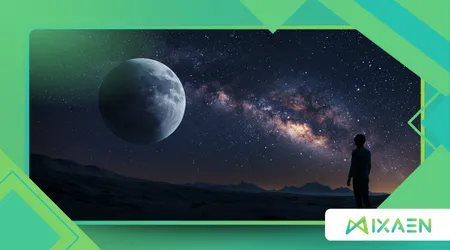Are We Looking for Alien Life in the Wrong Way?

Looking for Alien Life in the Wrong Way might be the question astronomers and astrobiologists are quietly wrestling with in 2025.
Anúncios
The search for extraterrestrial life has captivated humanity for centuries, from ancient philosophers pondering distant worlds to modern scientists scanning exoplanet atmospheres with the James Webb Space Telescope (JWST).
Yet, despite decades of effort, no definitive evidence of alien life has emerged. This absence prompts a provocative thought: are our methods flawed?
Are we too anchored to Earth-centric assumptions, chasing biosignatures that may not apply to alien worlds?
This article dives into why our approach to finding extraterrestrial life might need a radical rethink, exploring innovative ideas, real data, and fresh perspectives to spark curiosity about our place in the cosmos.
The quest for alien life is not just about technology but about imagination. We’ve built incredible tools like JWST and the Transiting Exoplanet Survey Satellite (TESS), which have confirmed over 5,983 exoplanets as of August 2025. But tools alone don’t guarantee success.
Our search hinges on assumptions about what life looks like assumptions that might be limiting our discoveries.
This piece will challenge those assumptions, propose bold new directions, and ask: what if the universe’s lifeforms are nothing like us?
The Earth-Centric Bias in Our Search
Humanity’s hunt for alien life often mirrors our own biology. We prioritize planets with liquid water, oxygen, or methane hallmarks of Earth’s biosphere.
This focus stems from a logical premise: Earth is our only known example of a life-bearing planet. However, this approach risks tunnel vision.
Life elsewhere might thrive in conditions we’d deem hostile, like the methane lakes of Titan or the subsurface oceans of Europa.
Consider extremophiles on Earth microbes flourishing in scalding vents or acidic springs. They prove life adapts to extreme environments. Yet, our telescopes often target “habitable zones” around stars, where liquid water might exist.
This narrows our scope, potentially overlooking planets with exotic biochemistries. For instance, K2-18b, a sub-Neptune 124 light-years away, showed traces of dimethyl sulfide in 2023, a possible biosignature.
But skepticism persists, as follow-up studies in 2025 found no conclusive evidence, highlighting how our expectations shape interpretations.
Our bias extends to technology. SETI (Search for Extraterrestrial Intelligence) scans for radio signals, assuming advanced civilizations communicate like we do.
++ What If the First Alien We Find Is Just a Microbe?
What if they use quantum signals or something unimaginable? Looking for Alien Life in the Wrong Way means clinging to familiar patterns, ignoring the universe’s vast possibilities.
The reliance on Earth-like conditions also skews our data analysis. Spectroscopy, used to detect atmospheric gases, often seeks familiar molecules like oxygen.
But alien life might produce gases we haven’t considered, like phosphine or exotic hydrocarbons. Our algorithms, trained on Earth’s chemistry, might miss these signals entirely. This calls for broader chemical models, ones that don’t assume life mimics our own.

Technology’s Limits and Opportunities
The tools we use to hunt for life are marvels of engineering, but they come with constraints. JWST’s infrared spectroscopy can analyze exoplanet atmospheres, revealing chemical compositions.
Yet, it struggles with faint signals from distant, small planets. The radial velocity method, detecting stellar wobbles, favors massive planets close to their stars, like hot Jupiters, over Earth-like worlds.
TESS, launched in 2018, has identified thousands of exoplanet candidates by observing brightness dips during transits. But it’s biased toward short-orbit planets, missing those in wider, potentially habitable orbits.
These technological limits shape what we find, often steering us toward planets unlike Earth. Looking for Alien Life in the Wrong Way could mean over-relying on these methods without diversifying our approach.
Emerging technologies offer hope. The Giant Magellan Telescope, set to operate in the late 2020s, will enhance atmospheric studies with unprecedented sensitivity.
Also read: The TRAPPIST-1 System: A Real-Life Sci-Fi Neighborhood
Its G-CLEF instrument could detect subtle biosignatures on smaller exoplanets. Meanwhile, citizen science projects like Exoplanet Watch engage amateurs to analyze light curves, expanding our data pool. These advancements suggest a shift toward more inclusive searches.
Yet, technology alone isn’t enough. We must rethink what we’re searching for. For example, the Breakthrough Listen initiative, backed by $100 million since 2015, scans for technosignatures signs of alien technology like laser pulses.
But what if aliens don’t build megastructures or emit detectable signals? We need to explore unconventional markers, like artificial light on a planet’s night side, as proposed by Harvard’s Avi Loeb.
The Biosignature Dilemma
Biosignatures chemicals like methane or oxygen are central to our search. But they’re not foolproof. Abiotic processes, like volcanic activity, can mimic life’s chemical fingerprints.
The 2023 K2-18b study, published in Astrophysical Journal Letters, detected dimethyl sulfide at a 99.7% confidence level, a molecule tied to marine algae on Earth.
Yet, 2025 follow-ups questioned its presence, showing how tricky interpretation can be. Looking for Alien Life in the Wrong Way might involve overemphasizing single molecules without context.
Consider an analogy: searching for life is like trying to identify a chef’s recipe from one spice. A pinch of cumin suggests curry, but it could be tacos.
Read more: Life on Super-Earths: Could We Survive There?
Similarly, a gas like methane could point to life or just geology. We need a holistic approach, combining multiple biosignatures with planetary context, like surface temperature or stellar type.
Future missions, like the Habitable Worlds Observatory, aim to refine this process. By targeting Earth-like planets, they’ll analyze atmospheric compositions in detail.
But we must expand our biosignature library. Research from 2024 suggests marine science could help, as exo-oceans might host life producing unique chemical signals, like those in Earth’s deep-sea vents.
The challenge lies in distinguishing life from non-life. For instance, Venus’s phosphine detection in 2020 sparked debate, as abiotic sources couldn’t be ruled out.
We need models that account for alien chemistries, perhaps incorporating machine learning to spot patterns humans might miss. This shift could redefine how we interpret data.
Cultural and Philosophical Assumptions
Our search isn’t just scientific it’s cultural. Science fiction, from Star Trek to Dune, shapes our expectations of alien life as humanoid or communicative.
This influences funding and research priorities. Governments and institutions like NASA prioritize habitable zone planets, assuming life needs Earth-like conditions. But what if life thrives in gas giant atmospheres or on rogue planets, unbound by stars?
The Fermi Paradox why haven’t we found aliens despite the galaxy’s vastness? looms large. It assumes intelligent life wants to be found. Maybe aliens are silent, avoiding detection.
Looking for Alien Life in the Wrong Way could mean expecting them to mirror our ambitions or technologies. Imagine a civilization that communicates via bioluminescence, invisible to our radio telescopes.
Public perception also plays a role. SETI’s focus on radio signals stems from 20th-century optimism about interstellar communication.
Yet, a 2025 study from the Center for Astrophysics suggests persistent light signals on exoplanet night sides could indicate cities. This idea, though speculative, pushes us to rethink what “alien” means.
We must also consider time. Civilizations might rise and fall before we notice.
The Drake Equation, estimating communicative civilizations, remains speculative because we lack data on life’s longevity. Our search might be too brief, missing signals from long-extinct or future species.
A New Path Forward
To find alien life, we need bold shifts. First, diversify biosignature searches. Instead of focusing on oxygen or methane, explore exotic gases like chloromethane, which could indicate non-Earth-like life.
Second, expand technosignature hunts. Beyond radio waves, look for infrared excesses from Dyson spheres or gravitational wave anomalies from advanced engineering.
Interdisciplinary approaches are key. Marine science, as shown in a 2024 PMC study, highlights exo-oceans as prime targets.
Collaborating with chemists, biologists, and AI experts could uncover new biosignatures. For example, AI could analyze spectral data for unexpected patterns, like a chef spotting a new flavor in a dish.
Citizen science offers practical help. Projects like SETI@home and Exoplanet Watch process vast datasets, freeing scientists for analysis.
Imagine a backyard astronomer in Brazil spotting a transit anomaly, contributing to a global discovery. Or picture a student in India using AI to flag a strange atmospheric signal real people making real impacts.
Finally, we must challenge philosophical assumptions. Life might not want contact. It might be microbial, not intelligent, or exist in forms we can’t imagine.
Looking for Alien Life in the Wrong Way risks missing these possibilities. Let’s embrace the unknown, asking: are we ready to find life that defies our expectations?
The Role of Imagination in Science

Science thrives on imagination, yet our search often lacks it. We’re tethered to Earth’s blueprint, assuming alien life resembles ours. But what if it’s silicon-based, thriving in liquid methane?
A 2025 SETI Institute report urges exploring non-carbon chemistries, inspired by Titan’s methane lakes. This shift demands creative thinking.
Take the TRAPPIST-1 system, with seven Earth-sized planets. JWST data from 2025 suggests TRAPPIST-1d lacks an atmosphere, but outer planets might hold water.
Imagining life in such systems requires flexibility perhaps life exists in subsurface oceans, invisible to our scopes. Looking for Alien Life in the Wrong Way means ignoring these possibilities.
Fiction can inspire science. Project Hail Mary by Andy Weir imagines life in stellar coronae, pushing scientists to consider extreme environments.
Similarly, researchers could explore rogue planets, warmed by internal heat, not stars. Imagination, paired with data, could unlock new frontiers.
Here’s a practical example: a team in 2025 used machine learning to reanalyze Kepler data, identifying 50 new exoplanet candidates.
By thinking beyond standard models, they found planets others missed. This shows how creativity, not just technology, drives discovery.
Table: Exoplanet Detection Methods and Their Biases
| Method | How It Works | Strengths | Biases |
|---|---|---|---|
| Transit Photometry | Measures star brightness dips during transits | Detects small planets, habitable zones | Favors short-orbit planets, misses wide orbits |
| Radial Velocity | Detects star wobble from planet gravity | Measures planet mass, orbit details | Biased toward massive, close-in planets |
| Direct Imaging | Captures planet’s light directly | Reveals planet appearance, orbit | Limited to bright, distant planets |
| Microlensing | Uses gravity to magnify starlight | Finds distant, small planets | Rare events, hard to confirm |
Source: NASA Exoplanet Exploration Program, 2025
Conclusion: Redefining the Search
The universe is vast, and our search for life is just beginning. Looking for Alien Life in the Wrong Way challenges us to rethink our methods, biases, and dreams.
With over 5,983 exoplanets confirmed, per NASA’s 2025 data, the odds of life are tantalizing. Yet, our Earth-centric lens, limited tools, and cultural assumptions may blind us to alien realities.
By embracing diverse biosignatures, new technologies, and bold ideas, we can expand our cosmic hunt. Are we ready to meet life that doesn’t look like us? Let’s venture into the unknown with open minds.
The path forward requires courage. Scientists, citizen astronomers, and dreamers must collaborate, blending data with imagination.
Projects like Exoplanet Watch show anyone can contribute, analyzing light curves from home.
The next breakthrough might come from a telescope in Chile or a laptop in Tokyo. Let’s keep asking questions, challenging norms, and searching for the unexpected.
Frequently Asked Questions
1. Why do we assume alien life needs water?
Earth’s life depends on water, so we prioritize it. However, life could use other solvents, like methane, as seen on Titan.
2. What are technosignatures?
Technosignatures are signs of alien technology, like radio signals, laser pulses, or artificial light, as explored by Breakthrough Listen.
3. How can citizens help find exoplanets?
Join projects like Exoplanet Watch to analyze telescope data. Your light curve analysis could confirm a new planet.
4. Is K2-18b proof of alien life?
No, 2025 studies questioned its dimethyl sulfide signal. It’s a promising world, but more data is needed.
5. What’s the Fermi Paradox?
It’s the question of why we haven’t found aliens despite the galaxy’s size, suggesting we might be missing key signals.
